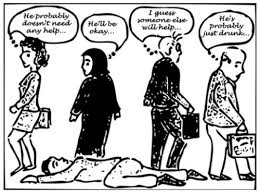The Bystander Effect
Written and published by , on 01st December 2016

The decision model of bystander intervention outlines the steps taken in order to reach the decision of helping: first, a person must notice the incident; second, the person must decide whether it represents an emergency or not; third, if interpreted as an emergency the person is left with the choice of assuming responsibility; fourth, the person must assess their competence to help the person in need; finally, the fifth step represents the decision to intervene. A negative response at any of these stages prevents helping behavior. A series of experiments established that there is a negative correlation between the willingness to help and the number of bystanders witnessing the event. The group size that the bystander is part of has adverse effects on two of the stages comprised in the model of bystander intervention. In interpreting the event as an emergency when other people are present, the bystander relies on the social cues in order to make such decision and by witnessing the inaction of the other bystanders present the bystander may wrongly infer that intervention is not necessary. This phenomenon is referred to as pluralistic ignorance. Another negative effect of group size refers to diffusion of responsibility which manifests when the bystander is faced with the decision of taking responsibility. As more people are present the responsibility to becomes diffused between all those who are witnessing the event which causes the bystander to feel less responsible on the premise that someone else will eventually intervene.
